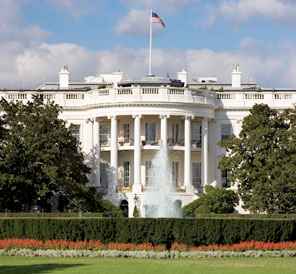Government Leading by Example

© iStockphoto.com/bluestocking
President George W. Bush has called on the Federal government to lead by example, be a good neighbor, and be a good environmental steward while, at the same time, meeting its missions in an efficient and reliable manner. In other words, he has challenged the Federal community to manage its environmental and energy footprint in a sustainable manner. But what is “sustainability”? There are many definitions. Suffice to say that, at the core, most definitions concur that the essence of sustainability includes the advancement of societies in a way that balances the social, economic and environmental needs of current and future generations.
Americans look to the Federal community to lead by example in fulfilling our national goals of supporting a strong economy, ensuring energy security, protecting our environment and natural resources and promoting technology transfer. Part of this role includes how we manage our environmental, energy and transportation footprint in the process of meeting our respective agency missions. The Federal government is one of the world’s largest organizations – in number of buildings, in number of fleet vehicles and in sheer purchasing power. We are the single-largest buyers and users of energy, spend billions of dollars on information technology equipment and manage or own nearly 1 in every 5 acres of land in America. Our size provides us with the ability to transform markets. It is imperative that we be good stewards of our natural resources and the environment yet, at the same time, operate efficiently and successfully to meet our missions.
As the Federal Environmental Executive (FEE), my office’s mission is to promote sustainable environmental stewardship throughout the Federal government in order to progress us on our journey toward this state of sustainability. We define “sustainable environmental stewardship” to include those concepts, strategies, tools, practices and approaches that lead to environmental improvement that is sustainable over time, considers the long-term effects as well as the short-term, more immediate effects, and contributes positively, even if indirectly, to the social and economic condition. Clearly, policies and actions related to sustainability will be rather far-reaching and deal not only with environmental but also with social, economic, health, education and related fields. As the FEE, I get to focus on the environmental contribution to that broad picture. It is understood; however, that the ideas and practices we promote are in line with the broader concept and will lead to overall, long-term improvement of society, the economy as well as the environment. To that end, we also work closely with our colleagues on the economic and social side of the equation.
I have the unique privilege to help craft government-wide policy and practices that will lead to us being more sustainable. I get to look at the government not so much as a policy and law-making body but as a very large organization with millions of employees, thousands of facilities and a very diverse portfolio. With this comes a notable environmental, energy and related economic footprint that needs to be managed. But also with this challenge comes great opportunity – to catalyze the marketplace, to partner with our private and public sector stakeholders and to lead by example.
While we can establish national policies, it is the Federal workforce, in its daily activities located throughout the country and the world, that makes sustainability happen. How we manage and integrate environmental and energy aspects into our operations is key to success in meeting our mission and, at the same time, achieving our environmental and energy vision.
We connect the broad national goals with our day-to-day activities in large part through Presidential Executive Order 13423, Strengthening Federal Environmental, Energy, and Transportation Management, signed by President Bush in January of 2007. The order sets goals in the areas of energy efficiency, acquisition, renewable energy, toxics reductions, recycling, renewable energy, sustainable buildings, electronics stewardship, fleets and water conservation. In addition, the order requires more widespread use of Environmental Management Systems as the framework in which to manage and continually improve these sustainable practices. This order is a timely and strategic step forward, building upon the many and notable accomplishments of the Federal community. The order integrates the sustainable practices of prior executive orders into a more cohesive approach to environmental and energy management – moving toward sustainability.
The story to date is very encouraging. Over the years we continue to demonstrate the very successful efforts of the Federal community. Examples of waste reduction, energy efficiency and affirmative procurement are plentiful across the entire landscape of Federal operations. More importantly, we continue to see the evolution of a strategic, holistic approach to environmental and energy management, where more integrated practices are replacing the outdated, isolated efforts approach. In addition, we have seen growth in the areas of cooperative conservation and environmental management systems, representing management philosophies and frameworks within which we perform many sustainable practices. The future does, indeed, hold great promise, and I am honored and privileged to play a small role in shaping that future.




























